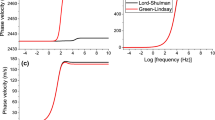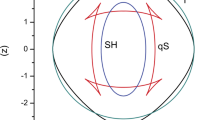Abstract
The simulation of wave propagation in high-temperature media requires thermoelastic theory. In this paper, we apply the rotated-staggered-grid pseudo-spectral method (RSG-PSM) to solving thermoelastic governing equations based on L-S theory. A time splitting method is used to solve the stiffness problem of the equations, and we introduce the rotated staggered pseudo-spectral operator and centered pseudo-spectral operator to compute the first-order spatial derivatives and second-order spatial derivatives, respectively. In the case of the heterogeneous-medium model, the Crank-Nicolson explicit method is used instead of the pseudo-spectral method to compute the wavefield. The properties and propagation of the thermal coupled wavefield are discussed, and we compare the simulation results obtained using the pseudo-spectral method, staggered-grid pseudo-spectral method, and RSG-PSM. In the case of an isotropic homogeneous medium, we obtain stable and highly accurate results using the time splitting method combined with the RSG-PSM. However, the algorithm cannot be applied with a large time step when the thermal conductivity changes dramatically, and the algorithm is unstable when the reference temperature has a gradient distribution. The optimal combined application of the mesh generation mode and numerical algorithm is explored, laying a foundation for the extension of these methods to thermoporoelasticity, thermoviscoelasticity, and anisotropy.
Similar content being viewed by others
References
Achenbach J D. 1973. Wave Propagation in Elastic Solids. Amsterdam: Elsevier. 129
Afanasiev M, Boehm C, van Driel M, Krischer L, Rietmann M, May D A, Knepley M G, Fichtner A. 2019. Modular and flexible spectral-element waveform modelling in two and three dimensions. Geophys J Int, 216: 1675–1692
Berezovski A, Berezovski M. 2013. Influence of microstructure on thermoelastic wave propagation. Acta Mech, 224: 2623–2633
Berezovski A, Engelbrecht J, Maugin G A. 2000. Thermoelastic wave propagation in inhomogeneous media. Archive Appl Mech-Ingenieur Archiv, 70: 694–706
Berezovski A, Engelbrecht J, Maugin G A. 2003. Numerical simulation of two-dimensional wave propagation in functionally graded materials. Eur J Mech-A/Solids, 22: 257–265
Berezovski A, Maugin G A. 2001. Simulation of thermoelastic wave propagation by means of a composite wave-propagation algorithm. J Comput Phys, 168: 249–264
Berezovski A, Maugin G A. 2002. Thermoelastic wave and front propagation. J Thermal Stresses, 25: 719–743
Biot M A. 1956. Thermoelasticity and irreversible thermodynamics. J Appl Phys, 27: 240–253
Boley B A, Weiner J H. 1960. Theory of Thermal Stresses. Mineola, NY: Dover Publishing. 586
Bouchon M, Campillo M, Gaffet S. 1989. A boundary integral equation-discrete wavenumber representation method to study wave propagation in multilayered media having irregular interfaces. Geophysics, 54: 1134–1140
Bracewell R N. 1978. The Fourier Transform and Its Applications. 2nd ed. New York: McGraw-Hill. 444
Brebbia C A. 1978. The Boundary Element Method for Engineers. London: Pentech Press. 189
Carcione J M. 2014. Wave Fields in Real Media: Wave Propagation in Anisotropic, Anelastic, Porous and Electromagnetic Media. 3rd ed. Amsterdam: Elsevier. 661
Carcione J M, Cavallini F, Wang E, Ba J, Fu L. 2019a. Physics and simulation of wave propagation in linear thermoporoelastic media. J Geophys Res-Solid Earth, 124: 8147–8166
Carcione J M, Quiroga-Goode G. 1995. Some aspects of the physics and numerical modeling of Biot compressional waves. J Comp Acous, 3: 261–280
Carcione J M, Wang Z W, Ling W, Salusti E, Ba J, Fu L Y. 2019b. Simulation of wave propagation in linear thermoelastic media. Geophysics, 84: T1–T11
Chakraborty A, Gopalakrishnan S. 2004. Thermoelastic wave propagation in anisotropic layered media—A spectral element formulation. Int J Comput Methods, 1: 535–567
Chen J K, Beraun J E, Grimes L E, Tzou D Y. 2003. Short-time thermal effects on thermomechanical response caused by pulsed lasers. J Thermophys Heat Transfer, 17: 35–42
Chester M. 1963. Second sound in solids. Phys Rev, 131: 2013–2015
Corrêa G J P, Spiegelman M, Carbotte S, Mutter J C. 2002. Centered and staggered Fourier derivatives and Hilbert transforms. Geophysics, 67: 1558–1563
Deresiewicz H. 1957. Plane waves in a thermoelastic solid. J Acoust Soc Am, 29: 204–209
Dong L G, Ma Z T, Cao J Z, Wang H Z, Geng J H, Lei B, Xu S Y. 2000. A staggered-grid high-order difference method of one-order elastic wave equation (in Chinese). Chin J Geophys, 43: 411–419
Francis P H. 1972. Thermo-mechanical effects in elastic wave propagation: A survey. J Sound Vib, 21: 181–192
Fu L Y, Mou Y G. 1994. Boundary element method for elastic wave forward modeling (in Chinese). Chin J Geophys, 37: 521–529
Green A E, Lindsay K A. 1972. Thermoelasticity. J Elasticity, 2: 1–7
Green A E, Naghdi P M. 1991. A re-examination of the basic postulates of thermomechanics. Proc R Soc Lond A, 432: 171–194
Hosseini S M. 2014. Application of a hybrid mesh-free method for shock-induced thermoelastic wave propagation analysis in a layered functionally graded thick hollow cylinder with nonlinear grading patterns. Eng Anal Bound Elem, 43: 56–66
Hosseini S M, Shahabian F, Sladek J, Sladek V. 2011. Stochastic meshless local Petrov-Galerkin (MLPG) method for thermo-elastic wave propagation analysis in functionally graded thick hollow cylinders. Comp Model Eng Sci, 71: 39–66
Hosseini zad S K, Komeili A, Akbarzadeh A H, Eslami M R. 2010. Numerical simulation of elastic and thermoelastic wave propagation in two-dimensional classical and generalized coupled thermoelasticity. In: ASME 2010 10th Biennial Conference on Engineering Systems Design and Analysis. 135–145
Jain M K. 1984. Numerical Solution of Differential Equations. 2nd ed. New York: Wiley. 698
Kawase H. 1988. Time-domain response of a semi-circular canyon for incident SV, P, and Rayleigh waves calculated by the discrete wave-number boundary element method. Bull Seismol Soc Amer, 78: 1415–1437
Kosloff D, Reshef M, Loewenthal D. 1984. Elastic wave calculations by the Fourier method. Bull Seismol Soc Amer, 74: 875–891
Liu W T, Hu S T, Li J, Xiong Z H, Zhao Y A. 2008. Attenuation of seismic wave in thermal elastic medium and calculation of the corresponding Q value (in Chinese). Earthquake, 28: 39–45
Lord H W, Shulman Y. 1967. A generalized dynamical theory of thermoelasticity. J Mech Phys Solids, 15: 299–309
Lu Y, Peng S, Cui X, Li D, Wang K, Xing Z. 2020. 3D FDTD anisotropic and dispersive modeling for GPR using rotated staggered grid method. Comput Geosci, 136: 104397
Lysmer J, Drake L A. 1972. A finite element method for seismology. In: Methods in Computational Physics: Advances in Research and Applications. New York: Elsevier. 181–216
Madariaga R. 1976. Dynamics of an expanding circular fault. Bull Seismol Soc Amer, 66: 639–666
Marfurt K J. 1984. Accuracy of finite-difference and finite-element modeling of the scalar and elastic wave equations. Geophysics, 49: 533–549
Maurer M J. 1969. Relaxation model for heat conduction in metals. J Appl Phys, 40: 5123–5130
Nettleton R E. 1960. Relaxation theory of thermal conduction in liquids. Phys Fluids, 3: 216–225
Özdenvar T, McMechan G A. 1996. Causes and reduction of numerical artefacts in pseudo-spectral wavefield extrapolation. Geophys J Int, 126: 819–828
Padovani E, Priolo E, Seriani G. 1994. Low and high order finite element method: Experience in seismic modeling. J Comp Acous, 2: 371–422
Robertsson J O A. 1996. A numerical free-surface condition for elastic/viscoelastic finite-difference modeling in the presence of topography. Geophysics, 61: 1921–1934
Rudgers A J. 1990. Analysis of thermoacoustic wave propagation in elastic media. J Acoust Soc Am, 88: 1078–1094
Saenger E H, Gold N, Shapiro S A. 2000. Modeling the propagation of elastic waves using a modified finite-difference grid. Wave Motion, 31: 77–92
Sánchez-Sesma F J. 1983. Diffraction of elastic waves by three-dimensional surface irregularities. Bull Seismol Soc Amer, 73: 1621–1636
Sarma G S, Mallick K, Gadhinglajkar V R. 1998. Nonreflecting boundary condition in finite-element formulation for an elastic wave equation. Geophysics, 63: 1006–1016
Serón F J, Sanz F J, Kindelán M, Badal J I. 1990. Finite-element method for elastic wave propagation. Commun Appl Numer Methods, 6: 359–368
Sumi N. 2001. Numerical solutions of thermoelastic wave problems by the method of characteristics. J Thermal Stresses, 24: 509–530
Veres I A, Berer T, Burgholzer P. 2013. Numerical modeling of thermoelastic generation of ultrasound by laser irradiation in the coupled thermoelasticity. Ultrasonics, 53: 141–149
Virieux J. 1984. SH-wave propagation in heterogeneous media: Velocity-stress finite-difference method. Geophysics, 49: 1933–1942
Wang K, Peng S, Lu Y, Cui X. 2020. The velocity-stress finite-difference method with a rotated staggered grid applied to seismic wave propagation in a fractured medium. Geophysics, 85: T89–T100
Wang Z W, Fu L Y, Wei J, Hou W, Ba J, Carcione J M. 2020. On the Green function of the Lord-Shulman thermoelasticity equations. Geophys J Int, 220: 393–403
Witte D, Richards P G. 1987. Contributions to the pseudospectral method for computing synthetic seismograms. SEG Technical Program Expanded Abstracts 1987, Society of Exploration Geophysicists. 517–519
Wu B N, Wu S Q, Huang Y, Feng B. 2012. Application of staggered grids in elastic wavefield modeling by pseudo-spectral method (in Chinese). Geophys Prospect Petrol, 51: 440–445+421
Zener C. 1948. Elasticity and Anelasticity of Metals. Chicago: University of Chicago Press. 170
Zou P, Cheng J B. 2016. Modified pseudo-spectral method for wave propagation modelling in arbitrary anisotropic media. In: 78th EAGE Conference and Exhibition 2016. Vienna. 1–5
Zou P, Cheng J. 2018. Pseudo-spectral method using rotated staggered grid for elastic wave propagation in 3D arbitrary anisotropic media. Geophys Prospecting, 66: 47–61
Acknowledgements
We thank the anonymous reviewers for their critical comments on the original manuscript and Glenn Pennycook, MSc, for editing the English text of a draft of this manuscript. This study was supported by the National Natural Science Foundation of China (Grant Nos. 41874125, and 41430322) and the National Key Research and Development Project (Grant Nos. 2018YFC0603701, and 2017YFC06061301).
Author information
Authors and Affiliations
Corresponding author
Electronic Supplementary Material
Rights and permissions
About this article
Cite this article
Li, Y., Liu, C., Guo, Z. et al. Simulation and characteristics analysis of a wavefield in a thermoelastic medium adopting the rotated staggered-grid pseudo-spectral method and L-S theory. Sci. China Earth Sci. 64, 1390–1408 (2021). https://doi.org/10.1007/s11430-020-9742-x
Received:
Revised:
Accepted:
Published:
Issue Date:
DOI: https://doi.org/10.1007/s11430-020-9742-x




